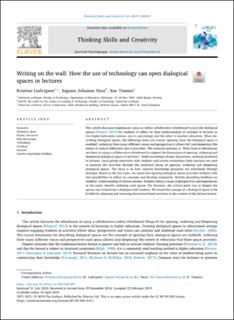| dc.contributor.author | Ludvigsen, Kristine | |
| dc.contributor.author | Ness, Ingunn Johanne | |
| dc.contributor.author | Timmis, Sue | |
| dc.date.accessioned | 2021-07-09T07:01:59Z | |
| dc.date.available | 2021-07-09T07:01:59Z | |
| dc.date.created | 2019-07-02T08:43:05Z | |
| dc.date.issued | 2019 | |
| dc.identifier.issn | 1871-1871 | |
| dc.identifier.uri | https://hdl.handle.net/11250/2763985 | |
| dc.description.abstract | This article discusses experiences using an online collaborative whiteboard to provide dialogical spaces (Wegerif, 2013) for students to reflect on their understanding of concepts in lectures in two higher-education courses: one in psychology and the other in teacher education. When describing dialogical spaces, the following terms are crucial: opening (how the dialogical space is enabled), widening (how many different voices and perspectives it allows for) and deepening (the extent of critical reflections that it provides). The research question is: ‘What kind of affordances are there in using a collaborative whiteboard to support the dimensions of opening, widening and deepening dialogical spaces in lectures?’ Audio recordings of peer discussions, material produced in lectures, focus-group interviews with students and course evaluations from teachers are used to examine the activities through the analytical lenses of opening, widening and deepening dialogical spaces. The focus is on how creative knowledge processes are stimulated through dialogue. Based on the two cases, we argue that opening dialogical spaces provides students with rich possibilities to reflect on concepts and develop arguments, thereby providing feedback on students’ understanding of course content. Students bring a range of perspectives and experiences to the scene, thereby widening such spaces. For lecturers, the critical point was to deepen the spaces and orchestrate a dialogue with students. We found the concept of a dialogical space to be fruitful for planning and assessing discussion-based activities in the context of the lecture format. | en_US |
| dc.language.iso | eng | en_US |
| dc.publisher | Elsevier | en_US |
| dc.rights | Attribution-NonCommercial-NoDerivatives 4.0 Internasjonal | * |
| dc.rights.uri | http://creativecommons.org/licenses/by-nc-nd/4.0/deed.no | * |
| dc.title | Writing on the wall: How the use of technology can open dialogical spaces in lectures | en_US |
| dc.type | Journal article | en_US |
| dc.type | Peer reviewed | en_US |
| dc.description.version | publishedVersion | en_US |
| dc.rights.holder | Copyright the authors | en_US |
| dc.source.articlenumber | 100559 | en_US |
| cristin.ispublished | true | |
| cristin.fulltext | original | |
| cristin.fulltext | original | |
| cristin.qualitycode | 1 | |
| dc.identifier.doi | 10.1016/j.tsc.2019.02.007 | |
| dc.identifier.cristin | 1709184 | |
| dc.source.journal | Thinking Skills and Creativity | en_US |
| dc.identifier.citation | Thinking Skills and Creativity. 2019, 34, 100559. | en_US |
| dc.source.volume | 34 | en_US |

